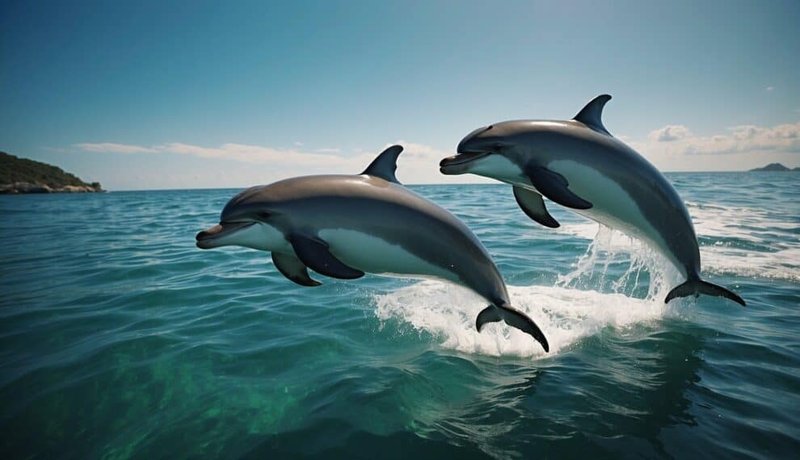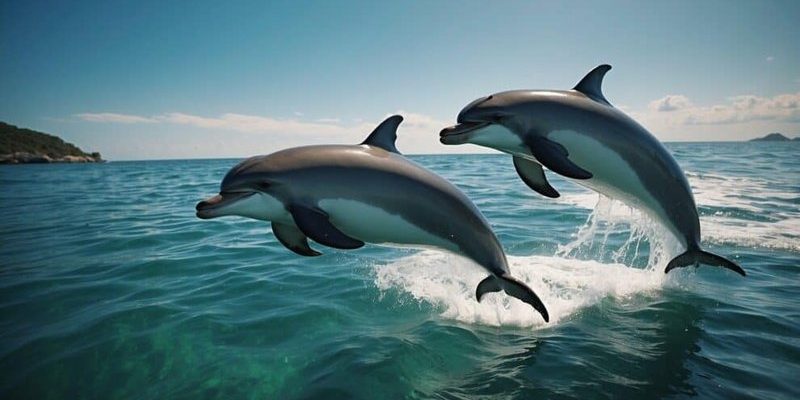
Imagine you’re trying to find your favorite coffee shop in a new neighborhood. You might rely on your phone’s GPS or ask a local for directions. Dolphins, on the other hand, have their own unique ways of finding their way around and socializing with friends. They rely on their *echolocation* and communication skills, which are quite sophisticated. Let me explain how they do this.
Understanding Echolocation
Echolocation is a fascinating technique dolphins use to understand their environment. When a dolphin clicks its tongue or produces a series of sounds, these noises travel through the water. Picture it like sending out little sonar waves, much like the radar used in airplanes. When these clicks hit an object, they bounce back, allowing the dolphin to form a mental picture of what’s around it.
This process is incredibly precise. Dolphins can detect the size, shape, and even texture of objects based on how the sound waves return to them. Imagine being able to “see” with sound! It helps them locate prey, avoid obstacles, and even communicate with other dolphins.
Many species of dolphins have evolved this skill to thrive in dark, murky waters. Without echolocation, they might struggle to find food. For example, a bottlenose dolphin can hunt for fish hidden in the sand or navigate through complex underwater landscapes, thanks to this remarkable ability.
Social Interaction Through Sound
Dolphins are not just solitary creatures; they are highly social animals. Communication is key in their communities, and they use a variety of sounds to interact with one another. These sounds include whistles, clicks, and even body language. Imagine having a conversation where most of your words are replaced by sounds and gestures!
Each dolphin has its own unique whistle, which is often referred to as a “signature whistle.” This is similar to a name, and it helps dolphins identify each other in a group. When they meet, they might exchange whistles, almost like greeting one another. This form of identity helps maintain social bonds among pods.
Here’s the thing: their communication isn’t just limited to individual interactions. When dolphins work together to hunt, they use specific sounds to signal their intentions. For instance, if one dolphin sees a school of fish, it might emit a certain call that alerts the others. This teamwork is crucial for their survival and demonstrates their intelligence.
The Role of Body Language
While sound is essential, body language plays a significant role in dolphin communication too. Dolphins are known for their playful behavior, often leaping out of the water or swimming in synchronized patterns. When they do these acrobatics, it’s not just for fun; it’s a way of expressing emotions and signaling to each other.
For example, a dolphin might breach the surface and make a big splash to show excitement. If a dolphin is feeling threatened or aggressive, it might display certain postures or movements. Other dolphins can pick up on these cues, allowing them to respond accordingly. It’s like having an unspoken language that enhances their interactions.
In addition to emotional cues, dolphins might use physical contact during communication. They often rub against each other or swim close together, reinforcing social bonds. These interactions create a sense of community and belonging, which is vital for their well-being.
Navigation Skills in the Open Ocean
Navigating in the vast ocean can be tricky, but dolphins have adapted to do so remarkably well. Their keen senses and instinctual knowledge help them find their way, even in unfamiliar waters. Using echolocation, they can detect underwater landmarks and get a sense of direction. But there’s more to the story.
Dolphins also rely on the sun and stars when traveling long distances. Just like ancient sailors, they can use celestial navigation to orient themselves. This ability, combined with their finely tuned echolocation skills, means they can travel thousands of miles with impressive accuracy.
You might wonder how they communicate during these journeys. Dolphins often travel in pods, and they stay close to each other, sharing sounds to ensure they’re all moving in the same direction. This collaboration strengthens their social bonds and makes navigation a group effort.
Challenges and Adaptations
Despite their impressive navigation and communication skills, dolphins face challenges in their environment. One major issue is noise pollution from boats, ships, and human activities. This can interfere with their echolocation and communication, making it harder for them to hunt or interact with each other.
Imagine trying to have a conversation in a loud, crowded room; it would be difficult to hear what someone is saying. Similarly, dolphins may become stressed or disoriented in noisy conditions. This is why marine conservation is crucial—it helps preserve their natural habitats and allows them to thrive.
Fortunately, dolphins are resilient. They have shown remarkable adaptability in dealing with changes in their environment. For instance, some studies suggest that dolphins can modify their vocalizations in response to background noise, adjusting their sounds so they can still communicate effectively. It’s a testament to their intelligence and ability to survive in a changing world.
Why Understanding Dolphins Matters
Understanding how dolphins navigate and communicate is essential for conservation efforts and deepening our appreciation for these amazing creatures. By recognizing their complex social behaviors and the challenges they face, we can better support their preservation.
Many organizations are dedicated to protecting dolphin habitats and raising awareness about their needs. Supporting these initiatives means we contribute to ensuring these remarkable animals continue to thrive in our oceans for generations to come.
If we take a moment to observe and appreciate dolphins’ skillful navigation and communication, we can foster a deeper connection with nature. It reminds us of the intricate web of life that exists in our oceans and the importance of protecting it.
In conclusion, dolphins are more than just intelligent animals; they’re skilled navigators and communicators. Their *echolocation*, unique sounds, body language, and adaptability showcase their remarkable abilities. By taking the time to understand these creatures, we can help ensure their future and create a world where both humans and dolphins can coexist harmoniously.

